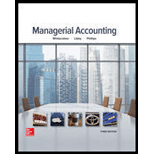
(a)
Contribution Margin:
The margin of profit which is computed after considering the variable cost only and not the fixed costis known as contribution. In other words, it means the contribution made by selling the product after covering its variable cost to the company.
The contribution margin ratio.
Answer to Problem 20E
The contribution margin ratio is
Explanation of Solution
Contribution Margin Income Statement:
| Particulars | Amount |
| Revenue | |
| Total variable cost | |
| Total Contribution Margin |
(b)
Concept introduction:
Breakeven Point:
The level of sales where the company is neither on profit nor loss is termed as breakeven point. In other words, that level of sales at which the fixed cost of the business is recovered.
To compute:
The breakeven point if the fixed cost is
Answer to Problem 20E
The breakeven point is
Explanation of Solution
| Particulars | Amount |
| Sales Price |
|
| Variable Cost per Canoe |
|
| Contribution Margin |
|
| Breakeven Sales |
The break-even point in units is calculated as:
(c)
Concept introduction:
Target Profit:
The target profit is that profit which a company decides to achieve and this analysis helps in determinig the level of sales by which this target can be achieved.
The total sales to achieve target profit of
Answer to Problem 20E
The target sale point is
Explanation of Solution
Contribution Margin Income Statement:
| Particulars | Amount |
| Sales Price |
|
| Variable Cost per Canoe |
|
| Contribution Margin |
The number units to be sold for achieving the target profit are calculated as:
(d)
Concept introduction:
Target Profit:
The target profit is that profit which a company decides to achieve and this analysis helps in determinig the level of sales by which this target can be achieved.
The sale revenue from each product to achieve target profit of
Answer to Problem 20E
The sale revenue from each product is divided as per their percentage ratio product mix which amounts to
Explanation of Solution
The number units to be sold for achieving the target profit are calculated as:
The share of sales of Thermos A will be
The share of sales of Thermos B will be
The share of sales of Thermos C will be
Want to see more full solutions like this?
Chapter 6 Solutions
Managerial Accounting
- What is the degree of operating leverage?arrow_forward??!!arrow_forwardLavigne Solutions allocates manufacturing overhead based on machine hours. Each unit is expected to require 10 machine hours. According to the static budget, Lavigne expects to incur the following: 1. 600 machine hours per month (units × 10 machine hours per unit) 2. $7,800 in variable manufacturing overhead costs 3. $11,200 in fixed manufacturing overhead costs - During September, Lavigne actually used 520 machine hours to make 52 units and spent $7,200 on variable manufacturing costs and $11,000 on fixed manufacturing overhead costs. What is Lavigne’s standard variable manufacturing overhead allocation rate?arrow_forward
- Principles of Accounting Volume 2AccountingISBN:9781947172609Author:OpenStaxPublisher:OpenStax College
 Managerial Accounting: The Cornerstone of Busines...AccountingISBN:9781337115773Author:Maryanne M. Mowen, Don R. Hansen, Dan L. HeitgerPublisher:Cengage Learning
Managerial Accounting: The Cornerstone of Busines...AccountingISBN:9781337115773Author:Maryanne M. Mowen, Don R. Hansen, Dan L. HeitgerPublisher:Cengage Learning Cornerstones of Cost Management (Cornerstones Ser...AccountingISBN:9781305970663Author:Don R. Hansen, Maryanne M. MowenPublisher:Cengage Learning
Cornerstones of Cost Management (Cornerstones Ser...AccountingISBN:9781305970663Author:Don R. Hansen, Maryanne M. MowenPublisher:Cengage Learning  Managerial AccountingAccountingISBN:9781337912020Author:Carl Warren, Ph.d. Cma William B. TaylerPublisher:South-Western College Pub
Managerial AccountingAccountingISBN:9781337912020Author:Carl Warren, Ph.d. Cma William B. TaylerPublisher:South-Western College Pub



